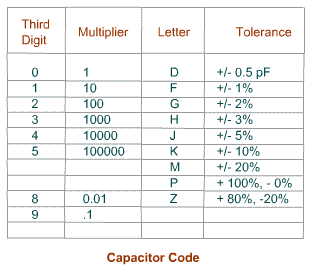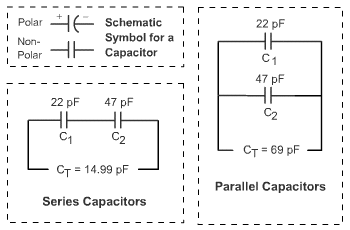Capacitor Values
Basic Electronics Part 1 – Passive Components
Determining Capacitor Values
The value of the capacitance in a capacitor can be determined by reading the prints in the capacitor. Often, high-capacitance capacitors, like electrolytic caps, have their values written explicitly in their casing; for example, 22 μF (Twenty two microfarads). However, smaller-valued capacitors have codes printed on them and not their actual value. This is because they usually come in very small sizes.
The code is usually a two-digit or three-digit code. The two-digit code plainly represents the capacitance value in picofarads (pF). For example, a ceramic capacitor that has “22” printed on it would simply mean that it has a capacitance of 22 pF. For the three-digit code, the first two digits are the significant digits and the third digit is the multiplier. As with the two-digit code, we read the values in the three-digit code in pF. For example, a ceramic capacitor that is printed with “104” has a capacitance of 10 x 10000 or 100,000 pF or 0.1 μF. It must be noted that the digits “6” and “7” are not used in the code.

Sometimes the code comes with a letter, say 104K. This letter represents the tolerance in the capacitance rating of the capacitor. For example, the 104K capacitor has a capacitance of 100,000 pf +/- 10%. That’s capacitance ranging from 90,000 pF to 110,000 pF.
Capacitors in Circuit Connections
Like resistors, two or more capacitors can be combined to obtain the desired capacitance value. When combining capacitors in a series connection, the capacitance is decreased, while in a parallel connection the capacitance is increased. This is the opposite of what happens when we combine resistors.
In a series connection, the total resistance is equal to the reciprocal of the sum of the reciprocal values of the capacitors (1/Ct = 1/C1 + 1/C2 + 1/Cn). In a parallel connection, the total capacitance is obtained by adding the individual capacitance values of the connected capacitors (Ct = C1 + C2 + Cn).

In a series-parallel connection, the rules for obtaining capacitance values in series and in parallel are applied successively.
Previous | Next



0 Comments:
Post a Comment
<< back to Home